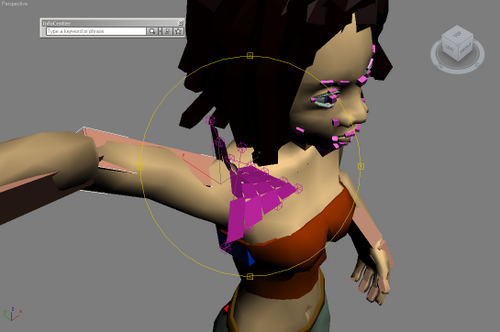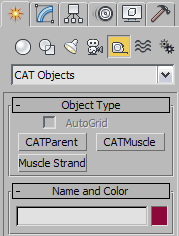In CAT, muscles are non-rendering helper objects that you can use to create a skin that looks realistic when stretched and deformed.
For example, the following illustration shows how the Marama rig's shoulder and upper arm have collapsed after being twisted and pulled in various directions. (Marama is one of the standard CATRigs included with CAT.)

Marama's shoulder will behave better once we finish applying the CATMuscle to her CATBones.
That happened because Marama's rigging includes no muscle objects; the skin shape is determined by the relative positions of the CATBones.
In the illustration, the purple patches are the segments of a CATMuscle that was created and shaped to use as muscles for her pectorals and shoulder. To complete the job, you would:
- Finish parenting the segments to appropriate positions on the CATBones.
- Drive the skinning with the CATMuscle rather than the CATBones.
Muscle Types

As the Create panel shows, you can create two kinds of muscles:
- CATMuscle: A planar (by default) helper object that is multi-segmented on both the U and V axes.
- Muscle Strand: A helper object that acts like a Bezier curve between two points. By default, the muscle strand is shaped like a cylinder that is thicker in the center and tapers off in size at the ends.
Usage
The muscle objects in CAT are designed to be used in three ways:
- As a set of procedural bone deformers. When either muscle object is set to Bones mode, you can add it to the Skin modifer like any other bone. It can also be exported to game engines.
- Both types of muscle objects, when set to Mesh mode, work well with the Skin Wrap modifier. For film and advertising jobs, Skin Wrap often provides superior performance with high-resolution meshes than does the Skin modifier.
- The CATMuscle object is designed to collide quickly and efficiently with the Muscle Strand, producing a nice skin-sliding effect. You could deform your mesh using CATMuscles, and then set up Muscle Strands underneath the CATMuscles, with the latter sliding over the strands. The Muscle Strand has controls for squash and stretch.